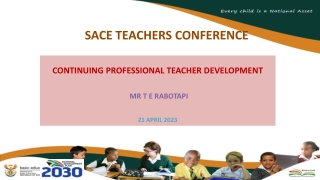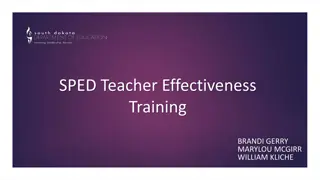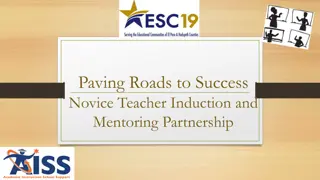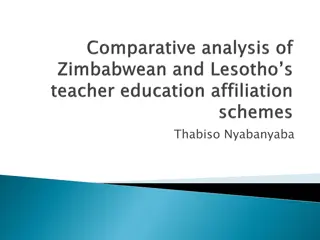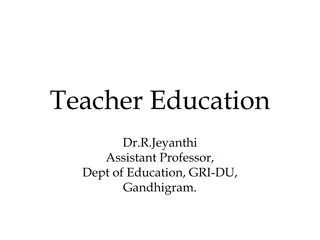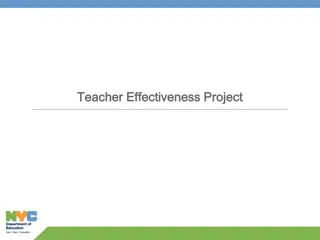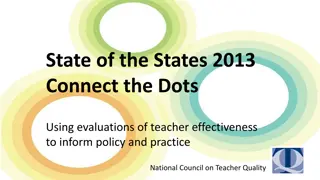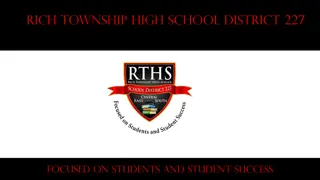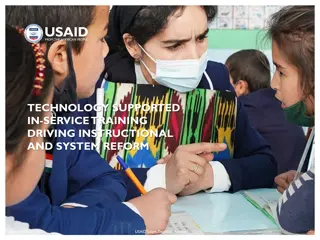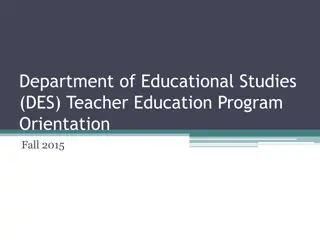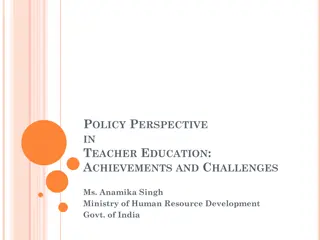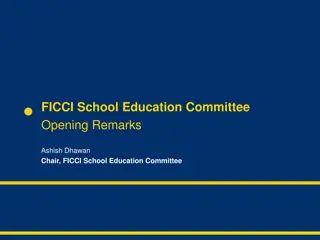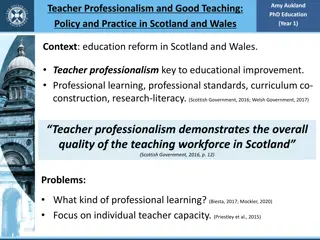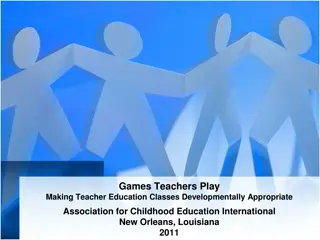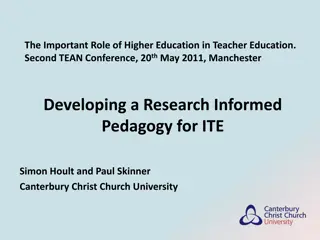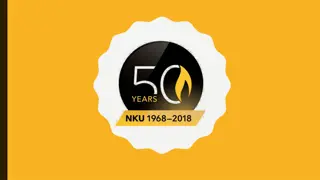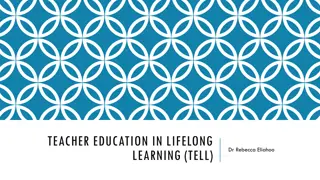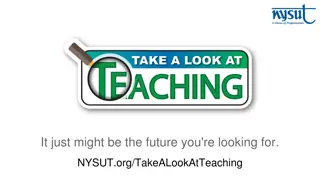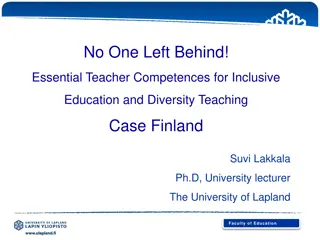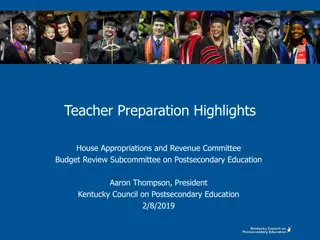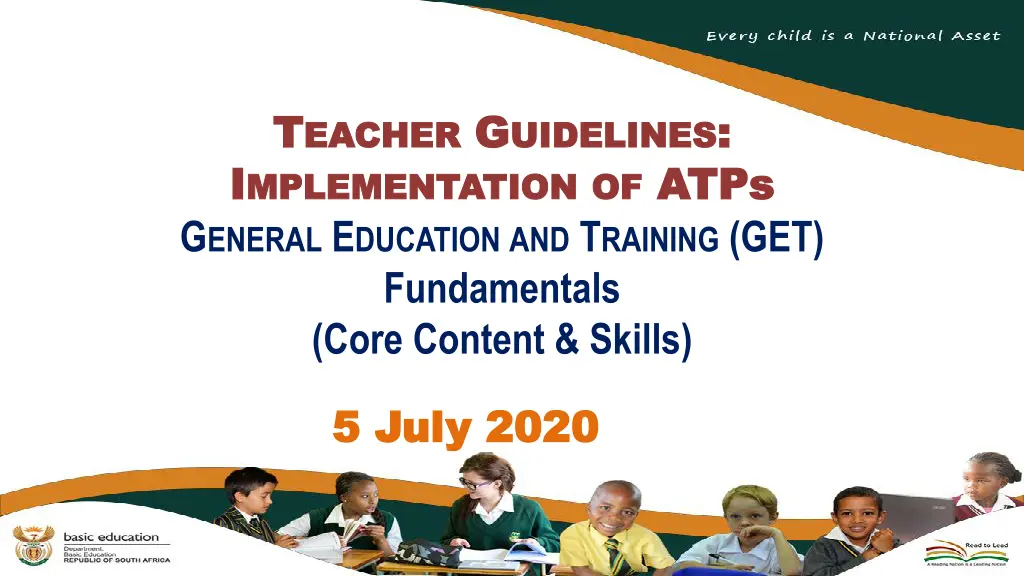
Implementation of General Education and Training Guidelines for Teachers
Explore the Teacher Guidelines for Implementing General Education and Training (GET) with a focus on core content and skills for different phases of education, from Foundation to Intermediate. Gain insights into prioritized topics and concepts across various subjects and phases for effective teaching strategies.
Download Presentation

Please find below an Image/Link to download the presentation.
The content on the website is provided AS IS for your information and personal use only. It may not be sold, licensed, or shared on other websites without obtaining consent from the author. If you encounter any issues during the download, it is possible that the publisher has removed the file from their server.
You are allowed to download the files provided on this website for personal or commercial use, subject to the condition that they are used lawfully. All files are the property of their respective owners.
The content on the website is provided AS IS for your information and personal use only. It may not be sold, licensed, or shared on other websites without obtaining consent from the author.
E N D
Presentation Transcript
T TEACHER I IMPLEMENTATION MPLEMENTATION OF GENERAL EDUCATION AND TRAINING (GET) Fundamentals (Core Content & Skills) EACHER G GUIDELINES UIDELINES: : OF ATPs ATPs 5 5 July 2020 July 2020
Contents Contents Purpose Foundation Phase Subjects Intermediate Phase Subjects Senior Phase Subjects Recommendations
Purpose Purpose To present core content and skills in the Teacher Guidelines for Implementing ATPs
F FOUNDATION Grade R Grade R- -3 3 OUNDATION P PHASE HASE
Curriculum Fundamentals: Grade R Curriculum Fundamentals: Grade R 3 3 Emphasis on Literacy and Numeracy with specific focus on reading, writing and number concept development The Life Skills component to be integrated into the languages with focus on health and safety. A thematic approach to lessons to be applied Greater contextual relevance of learning Fundamentals Fundamentals Ensure that Foundational Skills are not compromised. Current resources ( workbooks) to be utilised Need to provide notes / guidelines for parents and caregivers Implications Implications Focusing on the Home Language in Grade 1 and 2 Grade 3 more time allocated to EFAL Considerations Considerations
Foundation Phase (Grade R-3) FOUNDATION PHASE: FUNDAMENTALS TO BE PRIORITISED PROPOSED TOPICS/CONCEPTS PER PRIORITY Main focus should be on Reading and Writing: Life Skills to be integrated with Languages rather than spending additional time on Life Skills. The additional time gained from Life Skills can be used to have more time for Group-guided Reading Life Skills topics to be used for Reading With Comprehension as well as shared reading Languages Oral, Reading, and Writing Representation: - making mathematical ideas real by using words, pictures, symbols, and objects (like blocks). Spatial Orientation and Awareness geometry - introduction of the shape, size, space, position Measurement - Length, Height, Weight and Time Problem solving - Thinking, to Recognition Logical thinking skills Repeated addition leading to multiplication, grouping and sharing, sharing leading to fractions) Mathematics Numeracy and Number Concept Development Personal and social well-being (addressing social issues such as the corona virus) Languages to integrate Life Skills topics in reading with comprehension and shared reading/writing. Life Skills topics can also be used for oral and writing topics. Focus should be on safety and hygiene. Life Skills Safety and Hygiene Healthy Eating
I INTERMEDIATE Grade 4 Grade 4- -6 6 NTERMEDIATE P PHASE HASE
Curriculum Fundamentals: Grade 4 Curriculum Fundamentals: Grade 4 6 6 Mathematics and Languages, with specific focus on reading for meaning and writing and enumerating. Life Skills - Focus on Self-management, Health and Safety; performing and visual arts skills and concepts, creativity, communication skills and critical thinking skills Social Sciences Emphasis on Core Content and skills for both History & Geography within available time. NS & Tech - Emphasis on Core Content and skills for both Pedagogy to focus on translanguaging (refer to LiEP). Fundamentals Fundamentals A selection of core content and skills for the subjects will be provided. The core content and skills must be linked to critical outcomes. Ensure fundamentals are focussed on. Current resources ( workbooks) to be utilised Need to provide notes / guidelines for parents and caregivers Learning at home SBA including summative to be amended to focus on content and skills covered. Implications Implications
Home Languages (Grade 4-6) HOME LANGUAGES: FUNDAMENTALS TO BE PRIORITISED PROPOSED TOPICS/CONCEPTS PER PRIORITY Listening and Speaking Listening comprehension Prepared / Unprepared speech Reading aloud (prepared or unprepared) Response to texts (Reading Comprehension) o Literary or non-literary o Visual text o Summary Literature o Poetry o Short Story o Drama Reading and Viewing Writing and Presenting Essay Transactional texts Dictionary use Language conventions Vocabulary development Grammar o Word level o Phrases o Clauses o Sentences o Paragraphing o Critical language awareness Language Structures and Conventions
First Additional Languages (Grade 4-6) FUNDAMENTALS TO BE PRIORITISED PROPOSED TOPICS/CONCEPTS PER PRIORITY Listening comprehension Prepared / Unprepared speech FIRST ADDITIONAL LANGUAGES: Listening and Speaking Reading aloud (prepared or unprepared) Response to texts (Reading Comprehension) o Literary or non-literary o Visual text o Summary Literature o Poetry o Short Story o Drama Reading and Viewing Writing and Presenting Essay Transactional texts Dictionary use Language conventions Vocabulary development Grammar o Word level o Phrases o Clauses o Sentences o Paragraphing o Critical language awareness Language Structures and Conventions
Mathematics (Grade 4-6) FUNDAMENTALS TO BE PRIORITISED PROPOSED TOPICS/CONCEPTS PER PRIORITY Counting, ordering, representing and place value Performing all operations with whole numbers Common Fractions Decimal fractions (Grade 6 only) MATHEMATICS: Numbers, Operations And Relationships Patterns, Functions and Algebra (Grade 6 Only) Number sentence Numeric and Numeric Patterns Space And Shape (Grade 5 and 6 only) Properties of 3D objects Measurement Area, Perimeter and Volume
Life Skills (Grade 4-6) LIFE SKILLS: PROPOSED TOPICS/CONCEPTS PER PRIORITY Basic hygiene principles (issues of COVID-19) Emotions: Understanding a range of emotions Self-management skills Healthy environment and personal health: home, school and community; Safety measures at home and the environment HIV and AIDS education: basic facts o Risks of COVID -19 on people with chronic diseases o Transmission of the virus- COVID 19 Cultures and moral lessons Concepts: discrimination, stereotype and bias; Child abuse; Dealing with violent situations Issues of age and gender Physical fitness programme to develop particular aspects of fitness FUNDAMENTALS TO BE PRIORITISED Development of the Self Health and environmental Responsibility Social Responsibility Physical Education Physical warm up and relaxation exercises (spinal warm up, body part isolations, floor work, knee bends and rises, jumps and leaps, flexibility, etc.). Vocal/singing warm ups (breath control exercises, etc.) Posture/ concentration/ focus/ trust and listening games. Singing warm ups (traditional & SA songs: unison, canon, two-part harmony, call and response) Creative games; Improvisation and creation of classroom drama/dance/music sequences Dance, drama music elements; Rhythmic patterns using body percussion/found, other instruments. Performing Arts Visual Art: Create in 2D; Create in 3D; Visual Literacy (art elements and design principles; skills and techniques for 2D &3D work. Visual Art
Natural Sciences & Technology (Grade 4-6) NATURAL SCIENCES & TECHNOLOGY: PROPOSED TOPICS/CONCEPTS PER PRIORITY FUNDAMENTALS TO BE PRIORITISED Grade 4 Materials around us (Solids, liquids and gases; Change of state; The water cycle) Grade 5 Uses of metals (Uses of metals; Other properties of metals) Grade 6 Solids, liquids and gases (Arrangements of particles) Mixtures (Mixtures of materials) Solution as a special mixture (Solutions; Soluble substances; Insoluble substances) Dissolving (Rates of dissolving) Matter and Materials Grade 4 Energy and Energy Transfer (Energy from the Sun) Energy around us (Energy) Grade 5 Stored energy in fuels (Fuels) Energy and electricity (Cells and batteries) Energy and movement (Elastic and springs) Grade 6 Electric circuits (A simple circuit; Circuit diagram) Electrical conductors and Insulators (Conductors; Insulators) Energy and Change
Social Sciences (Grade 4) SOCIAL SCIENCES: FUNDAMENTALS TO BE PRIORITISED PROPOSED TOPICS/CONCEPTS PER PRIORITY Symbols and Key Symbols as simple pictures or letters Symbols on a simple large scale map Reading a map of a farm, village or part of town using symbols and a key. Grid references Concept of alpha-numeric grid references Grid references for symbols on a simple grid Reading and giving grid references on a simple, large scale map Compass Directions north (N), south (S), east (E) and west (W) in local area - Compass directions (N, S, E and W) on a map People and food Food people eat from plants and animals Ways people get their food buying; growing; collecting, fishing, hunting. People and food Farming for self and family (subsistence farming) Farming crops and animals to sell (commercial farming). Location of main crop and stock farming areas in South Africa (symbols on a map) Select a life story of EITHER Nelson Mandela or Mahatma Gandhi and link them with the qualities of good leaders. Use the Historical concept of Time and chronology to demonstrate how different modes of transport have changed over time. Select examples from Transport on land, (including rail), transport on water and transport on air. Map Skills Food and Farming in South Africa Learning from Leaders Transport Through Time
Social Sciences (Grade 5) SOCIAL SCIENCES: FUNDAMENTALS TO BE PRIORITISED PROPOSED TOPICS/CONCEPTS PER PRIORITY South Africa from above (physical map) Coastal plain, escarpment, plateau (concepts and location of features in South Africa) Location of the Highveld, Lowveld, Great Karoo, Little Karoo, Kalahari and Namaqualand Main rivers of South Africa identifying the sources, major tributaries and directions of flow (map) Physical Features of South Africa Weather, Climate and Vegetation of South Africa NB: The entire topic must be taught When, why and where the first African farmers settled in Southern Africa Attitudes to land Interaction with Khoisan principles of generous acceptance of other people. (In Iron Age society it was important for political power that leaders accepted strangers and integrated them into their own societies). Social, political and economic structures Roles of men, women, boys and girls (Children were economically active from an early age and took pride in contributing to the well-being of the community. In their teens they were initiated and educated into the responsibilities of adulthood.) The role of the chief The role of cattle The first Farmers in Southern Africa Way of life in ancient Egypt Social structure in ancient Egypt Beliefs and religion Pharaohs Sphinx, pyramids and temples Hieroglyphics Mathematics and astrology Medicine and physicians: diseases, anatomy, physiology and clinical examinations An Ancient African Society (Egypt)
Social Sciences (Grade 6) SOCIAL SCIENCES: FUNDAMENTALS TO BE PRIORITISED PROPOSED TOPICS/CONCEPTS PER PRIORITY Introduction of key concepts on trade, example: Exchange, export and import of goods, primary goods, services, raw materials, etc. What people trade Trade as the exchange of goods Trade as buying and selling of goods for money. Why people trade Concepts raw materials, primary goods, manufactured goods, secondary products, skills and services, the export and import of goods as well as skills and services e.g. Cuban doctors in SA. Case study such as: A locally produced agricultural product e.g. oranges or apples for example, to a value enhanced product such as fruit juice, jam, canned fruit, etc. From gold to jewellery. Climate around the world January and July temperature maps - Wet and dry areas of the world Tropical rain forests Deforestation reasons, consequences with a case study. Hot deserts Location on earth Climate: temperature and rainfall patterns Natural vegetation and wildlife How people in a desert live examples of lifestyles. Trade Climate and Vegetation around the World
Social Sciences (Grade 6 Cont..) SOCIAL SCIENCES: FUNDAMENTALS TO BE PRIORITISED PROPOSED TOPICS/CONCEPTS PER PRIORITY Reasons for European exploration The European Renaissance 15th and 16th centuries: a turning point in European history New ideas and knowledge (including influence on Europe from elsewhere) Inventions: gunpowder, magnetic compass, caravel (including influence on Europe from elsewhere) Spreading the Christian religion Trade and making a profit Explorers from Europe find southern Africa How people govern themselves in a democracy: Our national government The first democratic government in South Africa 1994 Political parties and voting in national elections The purpose of the Constitution The role of Parliament The importance of rules and laws The justice system and equality under the law Democracy and citizenship Rights and responsibilities of citizens in a democracy Case study: Pius Langa - Chief Justice and Head of the Constitutional Court: 2005 2009 Case study: Fatima Meer: a leader in building democracy The Constitutional Court
S SENIOR GRADE 7 GRADE 7- -9 9 ENIOR P PHASE HASE
Curriculum Fundamentals: Grade 7 Curriculum Fundamentals: Grade 7 - - 9 9 Languages, Mathematics, Natural Sciences LO greater focus self management, health and safety, and on career guidance. A Choice of any Two from: Social Sciences EMS Technology Creative Arts Fundamentals Fundamentals The pressure on teachers and learners is lessened, and more focus will be on Deeper Learning. Subjects choices may accommodate teachers with comorbidities Ensure the core is focussed on in each subject Current resources ( workbooks) to be utilised Need to provide notes / guidelines for parents and caregivers Learning at home SBA and summative assessment to be amended to focus on content and skills covered. Implications Implications
Home Languages (Grade 7-9) FUNDAMENTALS TO BE PRIORITISED PROPOSED TOPICS/CONCEPTS PER PRIORITY Listening comprehension Prepared / Unprepared speech HOME LANGUAGES: Listening and Speaking Reading aloud (prepared or unprepared) Response to texts (Reading Comprehension) o Literary or non-literary o Visual text o Summary Literature o Poetry o Short Story o Drama Reading and Viewing Essay Transactional texts Writing and Presenting Dictionary use Language conventions Vocabulary development Grammar o Word level o Phrases o Clauses o Sentences o Paragraphing o Critical language awareness Language Structures and Conventions
First Additional Languages (Grade 7-9) FUNDAMENTALS TO BE PRIORITISED PROPOSED TOPICS/CONCEPTS PER PRIORITY Listening comprehension Prepared / Unprepared speech FIRST ADDITIONAL LANGUAGES: Listening and Speaking Reading aloud (prepared or unprepared) Response to texts (Reading Comprehension) o Literary or non-literary o Visual text o Summary Literature o Poetry o Short Story o Drama Reading and Viewing Essay Transactional texts Writing and Presenting Dictionary use Language conventions Vocabulary development Grammar o Word level o Phrases o Clauses o Sentences o Paragraphing o Critical language awareness Language Structures and Conventions
Mathematics (Grade 7-9) FUNDAMENTALS TO BE PRIORITISED MATHEMATICS: PROPOSED TOPICS/CONCEPTS PER PRIORITY Common Fractions Decimal fractions Integers (Grade 7 only) Numbers, Operations and Relationships (Grade 7 and 8 Only) Functions and Relationships Algebraic expressions Algebraic Equations Graphs Patterns, Functions and Algebra Geometry of straight lines Properties of 2D shapes Space and Shape (Grade 8 and 9) Area and Perimeter Surface Area and Volume Measurement
Life Orientation (Grade 7-9) CREATIVE ARTS: FUNDAMENTALS TO BE PRIORITISED PROPOSED TOPICS/CONCEPTS PER PRIORITY Concepts: personal diet and nutrition Goal-setting skills: personal lifestyle choices Challenging situations: depression, grief, loss, trauma crisis and anxiety Development of Self in Society Basic hygiene principles of COVID-19 Substance abuse Concept: environmental health Common diseases: TB, diabetes, epilepsy, obesity, anorexia, HIV and AIDS including COVID-19 Management of tuberculosis, diabetes, epilepsy, HIV and AIDS including COVID -19 Health and safety issues related to violence Human rights as stipulated in the South African Constitution Dealing with abuse Time-management skills Reading and writing for different purposes Options available after completing Grade 9 Knowledge of the world of work Career and subject choices Study and career funding providers Health, Social and Environmental Responsibility Constitutional Rights and Responsibilities World of Work Participation and movement performance in an outdoor recreational activity Safety issues relating to participation in recreational activities Physical Education
NATURAL SCIENCES (Grade 7-9) NATURAL SCIENCES: PROPOSED TOPICS/CONCEPTS PER PRIORITY FUNDAMENTALS TO BE PRIORITISED Grade 7 Properties of Materials (Boiling and melting points; Electrical conductivity; Heat conductivity) Separating Mixtures (Mixtures; Methods of physical separation) Acids, bases and neutrals (Properties of acids, bases and neutrals; Acid-base indicators) Introduction to the Periodic table of Elements (Arrangement of elements on the Periodic table; Some properties of metals, semi-metals and non- metals) Grade 8 Atoms (Atoms building blocks of matter; Sub-atomic particles; Pure substances; Elements; Compounds) Particle model of matter (The concept of the particle model of matter; Change of state; Density, mass and volume; Density and states of matter; Density of different materials; Pressure) Grade 9 Compounds (The Periodic Table; Names of compounds) Chemical reactions (Chemical equations to represent reactions; Balanced equations) Reactions of metals with oxygen (The general reaction of metals with oxygen; Reaction of iron with oxygen; Formation of rust; Ways to prevent rusting) Reactions of non-metals with oxygen (The general reaction of non-metals with oxygen; Reaction of carbon with oxygen) Acids & bases and pH value (The concept of pH value) Reactions of acids with bases: Part I (Neutralisation and pH) Matter and Materials Grade 7 Grade 8 Potential & Kinetic energy (Potential; Kinetic energy; Potential and kinetic energy in systems; Law of conservation of energy) Heat Transfer (Heating as a transfer of energy; Conduction; Convection; Radiation) Insulation & energy saving (Using insulating materials) Static electricity (Friction and static electricity) Energy transfer in electrical systems (Circuits and current electricity; Components of a circuit; Effects of an electric current) Series and parallel circuits (Series circuits; Parallel circuits) Visible light (Radiation of light; Spectrum of visible light; Opaque and transparent substances; Absorption of light; Reflection of light; Seeing light; Refraction of light) Grade 9 Forces (Types of forces; Contact forces; Field forces (non-contact forces)) Electric cells as energy systems (Electric cells) Resistance (Uses of resistors; Factors that affect resistance in a circuit) Energy and Change
Social Sciences (Grade 7) GEOGRAPHY: FUNDAMENTALS TO BE PRIORITISED PROPOSED TOPICS/CONCEPTS PER PRIORITY Structure of the Earth Core, mantle, crust, How the crust moves: Structure of the Earth Volcanoes: Location around the world (map) Earthquakes: Location of earthquakes around the world (map) Earthquakes: Case study of a selected earthquake, case studies should be from this century. Volcanoes and Earthquakes Definition of concepts, e.g. birth rate, death rate, infant mortality, life expectancy Factors affecting birth rates and death rates Disease: Widespread illnesses such as HIV and AIDS, tuberculosis, malaria, diarrhoea Pandemics of the past such as the Black Death in Europe, smallpox at the Cape (COVID-19 MUST BE INCLUDED) Water in South Africa Who uses South Africa s water (pie graph of water users) Availability of water and requirement in South Africa River health and the care of catchment areas Population Growth and Change Natural Resources and Conservation in South Africa
Social Sciences (Grade 7 Cont) FUNDAMENTALS TO BE PRIORITISED HISTORY: PROPOSED TOPICS/CONCEPTS PER PRIORITY Indigenous inhabitants of the Cape in 17th century Where African farmers were settled Reasons for the VOC (DEIC) permanent settlement at the Cape 1652 Results of the Dutch Slaves at the Cape Why slaves were brought to the Cape Where the slaves came from How slaves were brought to the Cape What it was like to be a slave at the Cape Causes and effects of slave resistance at the Cape Slave legacy at the Cape, including religion of Islam and the development of the Afrikaans language Colonisation of the Cape 17th 18th Centuries Arrival of British and the expanding frontiers of European settlement The eastern frontier of European settlement The eastern frontier of European settlement Case study: Chief Maqoma (1798 1873) and Xhosa resistance to British rule - Soldiers and officials Co-operation and Conflict on the Frontiers of the Cape Colony in the early 19th Century
Social Sciences (Grade 8) GEOGRAPHY: FUNDAMENTALS TO BE PRIORITISED PROPOSED TOPICS/CONCEPTS PER PRIORITY Settlements and Land use Rural settlements Urban settlements Investigation of a settlement - Project Settlement (Focus: Africa with a Focus on South Africa) South Africa s climate Difference between climate and weather Elements of weather (temperature, humidity, winds and precipitation) South Africa s climate: Kinds of climate: Tropical, subtropical, temperate. Bar and line graphs Climate Regions (Focus: South Africa and World)
Social Sciences (Grade 8 Cont..) HISTORY: FUNDAMENTALS TO BE PRIORITISED PROPOSED TOPICS/CONCEPTS PER PRIORITY Britain, diamond mining Increasing labour control over black workers: close compounds and migrant labour Further land dispossession and defeat of African kingdoms: Xhosa 1878 Further land dispossession and defeat of African kingdoms: Pedi and Zulu: 1879 Mining of gold and the conditions underground Migrant workers Increasing burden on women in the reserves, erosion of families Skilled and unskilled white workers Forms of labour resistance The city of Johannesburg The Mineral Revolution in South Africa European colonization of Africa in the late 19th century: Berlin conference 1884 Map of Africa (showing different colonising countries) Causes of colonisation Patterns of colonisation: which countries colonised which parts of Africa The Scramble for Africa
Social Sciences (Grade 9) GEOGRAPHY: FUNDAMENTALS TO BE PRIORITISED PROPOSED TOPICS/CONCEPTS PER PRIORITY Definition of concepts, for e.g. The Human Development Index (HDI) life expectancy, Per capita, Gross Domestic Product (GDP) Reasons for differences in development Historical factors such as colonialism Sustainable development including economic, social and environmental factors Development Issues Concept of weathering: o Physical weathering o Chemical weathering o Biological weathering o Impact of human activities on weathering Difference between weathering, erosion and deposition Case study: agriculture as a contributor to erosion Surface Forces that Shape The Earth
Social Sciences (Grade 9 Cont) HISTORY: FUNDAMENTALS TO BE PRIORITISED PROPOSED TOPICS/CONCEPTS PER PRIORITY The Universal Declaration of Human Rights after World War II Definition of racism Apartheid and the myth of race 1948 National Party and Apartheid Main apartheid laws in broad outline Case study: Group Areas Act: Sophiatown forced removals 1950s: Repression and non-violent resistance to apartheid SACP banned ANC programme of action Brief biography: Albert Luthuli, his role in the ANC and resistance to apartheid The Defiance Campaign Freedom Charter and Treason Trial Women s March Brief biographies: Helen Joseph and Lillian Ngoyi and their roles in resistance to apartheid Turning Points in Modern South African History Since 1948 Formation of PAC, 1959 Sharpeville massacre 1976: Soweto uprising: Causes, leaders, events of 16 June, spiralling events that followed throughout the country, longer-term consequences for resistance and repression 1990 release of Nelson Mandela and the unbanning of liberation movements Negotiations and violence 1990 1994 Democratic election 1994 Turning Points In South African History: 1960, 1976 And 1990
Technology (Grade 7) FUNDAMENTALS TO BE PRIORITISED TECHNOLOGY GRADE 7: PROPOSED TOPICS/CONCEPTS PER PRIORITY Definition and purpose Classification of structures Types of structures Action research: to stiffen materials / structures Investigate: What is magnetism? Practical investigation: Different types of permanent magnets Practical demonstration by the teacher on Magnetic and non magnetic metals. Case study: Recycling scrap metals. Simple electric circuits. Circuit diagrams Demonstration lesson: A simple electromagnet. Introduce learners to cranks and pulleys. Using an electromagnet to sort out metal in a scrap yard. Case Study: Examine pictures of cranes in order to get ideas to be used in the learner s own designs Write a design brief with specifications and constraints for a crane with electromagnet. Sketch two possible designs for a suitable crane using single VP perspective. Draw a circuit diagram for the electromagnet (with a light to show when it is on) Revise the 3D oblique drawing technique; line types; scale; dimensions. Drawing: Each learner uses the Oblique technique to draw an idea for the crane chosen from the two ideas sketched the previous week. The idea should be drawn on squared paper (quadrant) using pencil and ruler Structures Electrical Systems and Control
Technology (Grade 7 Cont) TECHNOLOGY GRADE 7: PROPOSED TOPICS/CONCEPTS PER PRIORITY FUNDAMENTALS TO BE PRIORITISED Find out what situations commonly result in people becoming refugees. Find out what initial problems are typically faced by refugees. What mix of people will usually be present? What are their needs for shelter? What are their needs for food and water? Investigate the types of food that can be supplied to occupants of a refugee camp. Design brief: learners write a design brief giving specifications of the types and quantities of food needed for a population of 100 refugees. Design: List the ingredients of a meal that will be nutritious as well as tasty, and which can be prepared under conditions likely to be found in a refugee camp Processing
Technology (Grade 8) FUNDAMENTALS TO BE PRIORITISED TECHNOLOGY GRADE 8: PROPOSED TOPICS/CONCEPTS PER PRIORITY REVISE: simple circuit components; input devices (electrochemical cell; generator; solar panel), output devices (resistor; lamp; heater; buzzer; motor); control device (switches). Note: Some devices can serve as input, output, process or control device. CORRECT CONNECTIONS, short circuits. Electrical components and their accepted symbols. DRAWING ELECTRICAL CIRCUITS using accepted symbols TEACHER SET UP CIRCUITS using a range of components. Learners draw the circuits using symbols Energy for heating, lighting and cooking in rural and informal settlements. Energy from illegal connections; ethical issues; safety considerations. GENERATE ELECTRICITY FOR THE NATION ADVANTAGES AND DISADVANTAGES of: Thermal power stations (steam turbines sources of heat: coal, gas, nuclear, sun). Hydroelectric power stations (including pumped storage schemes). Wind-driven turbines. ALTERNATING CURRENT; step-up and step-down transformers; distributing electric power across the country: the national grid. Investigation: AND logic gate and simple cases where it is used. Investigation: OR logic gate and simple cases where it is used. Lesson: truth tables for AND & OR logic conditions. Electrical Systems and Control
Technology (Grade 8 Cont) FUNDAMENTALS TO BE PRIORITISED TECHNOLOGY GRADE 8: PROPOSED TOPICS/CONCEPTS PER PRIORITY Calculate Mechanical advantage (MA) Levers: mechanical advantage calculations for levers using ratios. Calculations using LOAD/EFFORT; load ARM/effort ARM; etc. Gears: mechanical advantage calculations for gears using ratios. Calculations using tooth ratios; gear wheel diameters; velocity ratios. Sketches (2D) showing gear systems that: Provide an output force four times greater than the input force (MA = 4:1). SYSTEMS DIAGRAMS Analyse a mechanical system by breaking it into input-process-output. Draw a Systems Diagram for a gear system with a mechanical advantage of 4:1. INVESTIGATE: Bias in technology: Gender bias in career choice / opportunities related to mining. INVESTIGATE: Lifting mechanisms (wire rope-driven mine headgear) in use at South African mines for raising people and ore. Sketch: initial idea sketches to meet the requirements given in the scenario. Design brief with specifications and constraints. Mechanical Systems and Control
Technology (Grade 8 Cont) FUNDAMENTALS TO BE PRIORITISED TECHNOLOGY GRADE 8: PROPOSED TOPICS/CONCEPTS PER PRIORITY The Positive Impact of Technology: Case study 1: investigate the impact of plastic shopping bags on the environment. REPORT: learners write a report evaluating the effectiveness of using thicker, bio-degradable plastic shopping bags which shoppers must buy. Case study 2: technology with a positive impact on society. Investigate how waste paper and cardboard are recycled to produce new products for the packaging industry. Case study 3: technological products can have a negative impact. INVESTIGATE a technological product that can have a negative impact on society. Processing
Technology (Grade 9) FUNDAMENTALS TO BE PRIORITISED TECHNOLOGY GRADE 9: PROPOSED TOPICS/CONCEPTS PER PRIORITY Revise 1: Component symbols: Cells in series and parallel. Lamps in series and parallel. Switches in series (AND logic) and parallel (OR logic). Current in the circuit conventional current flows from positive to negative. Revise 2: simple circuits: One cell, switch, two lamps in series. Two cells in series, switch, two lamps in series. Ohm s law quantitatively: as voltage increases, current increases if resistance is constant. Resistor colour codes: Low value resistors often have their resistance value printed on them in numbers. Higher value resistors are coded using coloured bands. The first three bands give the value of the resistor in ohms. The fourth band is an accuracy rating as a percentage Electrical Systems and Control
Technology (Grade 9 Cont) FUNDAMENTALS TO BE PRIORITISED TECHNOLOGY GRADE 9: PROPOSED TOPICS/CONCEPTS PER PRIORITY CALCULATE VALUES: INVESTIGATE the situation and the nature of the need so that an appropriate circuit can be chosen to solve the problem, need or want given in the scenario. A given circuit must be incorporated into the design of a device that will use the electronics to address the problem, need or want. Electrical THE DESIGN BRIEF: Each learner writes his/her suggestion for the design with specifications & constraints. Systems and Control SKETCHES Each learner draws the circuit diagram. Each learner produces a sketch in 3D showing the device that will use the electronic circuit.
Technology (Grade 9 Cont) FUNDAMENTALS TO BE PRIORITISED TECHNOLOGY GRADE 9: PROPOSED TOPICS/CONCEPTS PER PRIORITY REVISION - Action research: learners experiment with two different sizes of syringes linked by a tube and filled with hydraulic fluid (water). Learners experience force transfer with either force multiplication or force division (depending on which syringe is the driver/master). Gases (like air) are compressible. Liquids (like water, oils) are incompressible. ACTION RESEARCH: Pascal s principle pressure exerted on one part of a hydraulic system will be transferred equally, without any loss, in all directions to other parts of the system. The Hydraulic Press (including simple calculations). The hydraulic jack Investigate: learners find out about the following mechanical control systems: Ratchet and pawl. Disc brake, Bicycle brake, Cleat. INVESTIGATE the situation so that an appropriate machine can be designed to solve the problem, need or want given in the scenario. Investigate the possible mechanisms and controls to be used together to make the machine. DESIGN BRIEF: each learner writes his/her suggestion for the design giving specifications and constraints. SKETCHES: each learner produces two sketches of viable possible designs. Mechanical Systems and Control
Technology (Grade 9 Cont) FUNDAMENTALS TO BE PRIORITISED TECHNOLOGY GRADE 9: PROPOSED TOPICS/CONCEPTS PER PRIORITY PRESERVING METALS (first two methods theoretically, Painting Galvanising Electroplating PRESERVING FOOD (first two methods theoretically, 2.3 practically) Storing grain Pickling Drying and/or salting Processing TYPES OF PLASTICS AND THEIR USES Investigation: identification of plastic identifying-codes and sorting for recycling. Properties of plastics Reduce reuse recycle CASE STUDY: Remanufacturing waste plastic into pellets for re-use. Systems diagram: Draw a systems diagram describing a plastics recycling project. Case study: Moulding recycled plastic pellets into products.
Technology 7 Technology 7- -9: Summary 9: Summary Technology-No groupwork and practical activities More focus on enabling activities that leads to formal assessments. Teachers and schools to provide guidance to parents on how to address some of the activities at home . E.g. (online videos on core content Whatsapp videos) District officials in collaboration with provincial heads to guide further.Teachers focus more on demonstration lessons. Fundamentals Fundamentals School context may determine the focus on the choices offered e.g. technical / focussed schools Subjects chosen may accommodate teachers with comorbidities Lost contact time will ensure core is focussed on in each subject Current resources ( workbooks) to be utilised Need to provide notes / guidelines for parents and caregivers Learning at home SBA to be amended to focus on content covered Implications Implications
Economic and Management Sciences (Grade 7) FUNDAMENTALS TO BE PRIORITISED PROPOSED TOPICS/CONCEPTS PER PRIORITY Capital; Assets; Liability; Income; Expenses; Profit; Losses; Budgets; Savings; Banking; Financial records; Transactions. ECONOMIC AND MANAGEMENT SCIENCESGRADE 7: Accounting Concepts Personal statement of net worth; Types of business income; Types of business expenses; Savings and investments in business Income and Expenses Definition of an entrepreneur; Characteristics and skills of an entrepreneur Entrepreneurial actions of buying, selling, producing and making a profit. Entrepreneurship Definition of production; inputs and outputs. Meaning of economic growth and productivity Production Process
Economic and Management Sciences (Grade 8) FUNDAMENTALS TO BE PRIORITISED PROPOSED TOPICS/CONCEPTS PER PRIORITY ECONOMIC AND MANAGEMENT SCIENCES GRADE 8: Transactions, Source documents; subsidiary journals; General Ledger; Trial Balance. Introduction of the Cash Journals of a service business. Accounting Cycle Cash transactions (receipts and payments) on the accounting equation. Assets = owner s equity + liability (A = OE + L) Accounting Equation Cash Payments Journal& Cash Receipts Journal (Service Business) Concept of a Cash Receipts Journal (CRJ) Cash Payments Journal (CPJ) of a service business; formats and uses of the columns in the CRJ and CPJ; Entering of cash transactions in the CRJ and CPJ; closing off the CRJ and CPJ; The double entry-principle; the T accounts; format of the General Ledger; sections within the General Ledger; opening accounts in the General Ledger, posting/recording of transactions from CRJ and CPJ of the service business to the General Ledger, balancing of the General Ledger, Preparing of a Trial Balance General Ledger and Trial Balance Types of markets- goods and services market. Types of markets -factor market (labour and financial markets) Markets
Economic and Management Sciences (Grade 9) FUNDAMENTALS TO BE PRIORITISED ECONOMIC AND MANAGEMENT SCIENCES GRADE 9: PROPOSED TOPICS/CONCEPTS PER PRIORITY Law of demand, law of supply, demand schedule, supply schedule, demand curve, supply curve, Graphical Illustration, equilibrium point, equilibrium quantity, equilibrium price Demand and Supply CRJ, CPJ of the Trading business, posting, trial balance and the effect of the cash transaction of the Trading business on the Accounting Equation. Credit transactions-debtors and creditors, posting to the debtors, creditors ledger and the effect of credit transactions on the Accounting equation. Recording payments of creditors to the CPJ and recording of debtors into the CRJ Cash Receipts Journal and Cash Payments Journal (Trading Business) Accounting Equation The effect of credit transactions on the Accounting equation. Debtors and Creditors Journals Credit transactions-debtors and creditors, posting to the debtors, creditors ledger and the effect of credit transactions on the Accounting equation. Recording payments of creditors to the CPJ and recording of debtors into the CRJ Debtors and Creditors Ledger Concepts, components and format of a business plan. SWOT analysis and financial plan. Business Plan
Creative Arts: Dance (Grade 7-9) FUNDAMENTALS TO BE PRIORITISED PROPOSED TOPICS/CONCEPTS PER PRIORITY Warm up. Floor work. Dance Conventions. Travelling, in combination, with safe landing. Leg strengthening, arm & joint mobility and control movements . Transfer of weight; Turns. Building stamina through jumps/ Aerial movements (jumps), with safe landing. Cool down. Short fast dance sequences. Dance steps and style from an indigenous South African Culture (Gr7 & 9) / Popular Dance / Social Dance (Gr 8). CREATIVE ARTS - DANCE GRADE 7-9: Dance Performance Improvisation and Composition of a short dance based on different stimuli & relationships; exploring an idea, mood or thought, using gestures literal to abstract. Contrasting dynamics. Dance elements: Relationships, Space, Time & Force. Dance Improvisation & Composition Posture & alignment, use of core, spine, safe landing. Warm up & cool down. Dance Literacy & Dance terminology in practical class. Different dance forms: social/popular dance /South African. Dance Theory & Literacy
Creative Arts: Drama (Grade 7-9) FUNDAMENTALS TO BE PRIORITISED PROPOSED TOPICS/CONCEPTS PER PRIORITY Vocal Development Breathing exercises - breath control and capacity Correct posture and alignment- (neutral position) Interpretation skills and related exercises: pause, pitch, pace, projection, intonation and tone Relaxation exercises CREATIVE ARTS DRAMA GRADE 7-9: Dramatic Physical Development Concentration and focus in movement Physical characterization: creating character and mood through movement Release of tension, loosening and energising the body Spinal warm-up, Trust exercises Warm-up using imagery to explore movement dynamics; understanding purpose of warming up and cooling down Skills Development Grade 7: Improvised dramas/scenes to explore structure of drama: beginning, middle and end. Grade 8 and Grade 9: Explore elements in a practical performance. Drama Elements in Playmaking Grade 7: Choral verse and/Folktales Grade 8: Dialogues and/or Indigenous poems/praise poetry written by South African poets. Grade 9: Dramatised prose and/or Scene work (theatre/television) Reflection on own and others performances, constructive feedback Media, video clips, pictures and career discussions to support reflection and appreciation. Interpretation and Performance of Selected Dramatic Forms
Creative Arts: Music (Grade 7-9) FUNDAMENTALS TO BE PRIORITISED PROPOSED TOPICS/CONCEPTS PER PRIORITY CREATIVE ARTS- MUSIC GRADE 7-9: Duration, clapping/drumming short rhythmic phrases that use crotchets, quavers, minims, semibreves, dotted minim, semibreves; polyrhythmic phrases. Letter names of notes on the treble and bass clef. Pitch: sight singing melodic phrases from known and unknown songs using tonic sol-fa. Music Literacy Active listening to a variety of recorded or live music by clapping or humming or moving along, describing: Meter of the music as duple or triple or quadruple time Tempo (fast/slow) Dynamics (soft/loud) Timbre Meaning or story of the music Lyrics of the music Texture of the music Music Listening Breathing exercises Continuous development of in-tune singing through a repertoire of songs (songs with descants; soprano/soprano; soprano/alto; soprano/baritone). Accompanying songs with body percussion, found or self-made instruments, traditional instruments, orff instruments. African drumming Rhythmic and melodic improvisation on an ostinato or riff. Writing own four-line song lyrics and melody based on a social issue. Performing and Creating Music
Creative Arts: Visual Art (Grade 7-9) CREATIVE ARTS VISUAL ARTS GRADE 7-9: PROPOSED TOPICS/CONCEPTS PER PRIORITY Art Elements and Principles of Design Visual Literacy: Visual analysis and interpretation, symbolic language recognition Techniques of art-making in 2D, process work FUNDAMENTALS TO BE PRIORITISED Create in 2D Art Elements and Principles of Design Visual Literacy: Visual analysis and interpretation, symbolic language recognition Techniques of art-making in 3D, process work Create in 3D Art Elements and Principles of Design Visual Literacy: Visual analysis and interpretation Developing research and communication skills, reflection Visual Literacy
RECOMMENDATION It is recommended that core content and skills in the Teacher Guidelines for Implementing ATPs be noted

